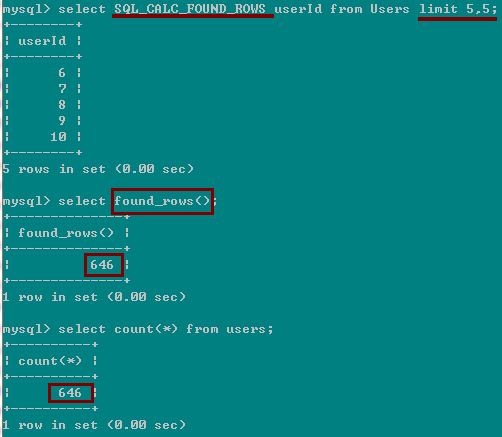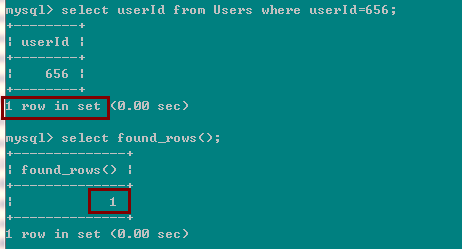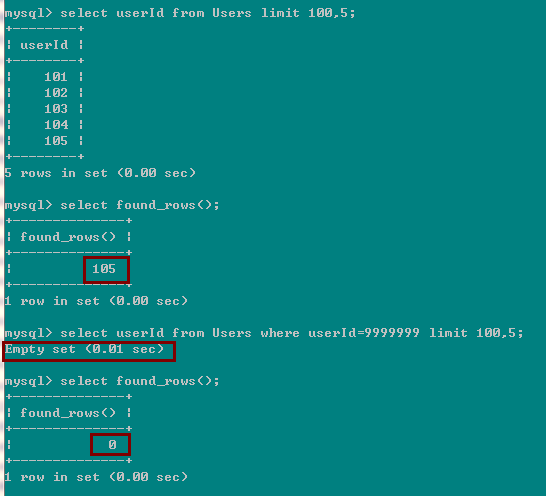MySQL 中的 FOUND_ROWS() 与 ROW_COUNT() 函数
移植sql server 的存储过程到mysql中,遇到了sql server中的:
IF @@ROWCOUNT < 1
对应到mysql中可以使用 FOUND_ROWS() 函数来替换。
1. found_rows() 函数
文档地址:http://dev.mysql.com/doc/refman/5.6/en/information-functions.html#function_found-rows
1)found_rows() 的第一种使用情况(带有SQL_CALC_FOUND_ROWS,):也带有
A SELECT statement may include a LIMIT clause to restrict the number of rows the server returns to the client. In some cases, it is desirable to know how many rows the statement would have returned without the LIMIT, but without running the statement again. To obtain this row count, include a SQL_CALC_FOUND_ROWS option in the SELECT statement, and then invoke FOUND_ROWS() afterward:
mysql>SELECT SQL_CALC_FOUND_ROWS * FROMtbl_name
->WHERE id > 100 LIMIT 10;
mysql>SELECT FOUND_ROWS();
The second SELECT returns a number indicating how many rows the first SELECT would have returned had it been written without the LIMIT clause.
前面的带有limit的select语句如果加上了 SQL_CALC_FOUND_ROWS,那么接下来执行的 SELECT FOUND_ROWS(); 将返回前面语句不带limit语句返回的行数。
此种情况下,select found_rows() 和 select count(*) 有一个很小的区别:如果userId允许为null,那么select found_rows() 的结果可能要比select count(*) 要小一些。因为前者等价于:select count(userId) from Users; 而该语句不会计算userId 为null的行在内。而count(*)会计算在内。
2)found_rows() 的第二种/第三中使用情况(不带有SQL_CALC_FOUND_ROWS):
In the absence of the SQL_CALC_FOUND_ROWS option in the most recent successful SELECT statement, FOUND_ROWS() returns the number of rows in the result set returned by that statement. If the statement includes a LIMIT clause, FOUND_ROWS() returns the number of rows up to the limit. For example, FOUND_ROWS() returns 10 or 60, respectively, if the statement includes LIMIT 10 or LIMIT 50, 10.
The row count available through FOUND_ROWS() is transient and not intended to be available past the statement following the SELECT SQL_CALC_FOUND_ROWS statement. If you need to refer to the value later, save it:
mysql>SELECT SQL_CALC_FOUND_ROWS * FROM ... ;
mysql>SET @rows = FOUND_ROWS();
If you are using SELECT SQL_CALC_FOUND_ROWS, MySQL must calculate how many rows are in the full result set. However, this is faster than running the query again without LIMIT, because the result set need not be sent to the client.
1> 第二种使用情况(不带有SQL_CALC_FOUND_ROWS,):也没有带 limit
如果前面的select语句没有带 SQL_CALC_FOUND_ROWS,也没有带 limit ,那么后面的 SELECT FOUND_ROWS(); 返回的结果就是前面的select返回的行数;

2> 第三中使用情况(不带有SQL_CALC_FOUND_ROWS,但是):有带 limit
如果前面的select语句没有带 SQL_CALC_FOUND_ROWS,但是带有 limit,那么后面的 就是limit语句到达的最大的行数,比如:select * from xxx limit 10; 到达的最大的行数为10,所以 found_rows() 返回10;比如 select * from xxx limit 50,10; 它要从第50行开始,再扫描10行,所以到达的最大的行数为60,所以SELECT FOUND_ROWS(); 返回的结果found_rows() 返回60。

这里第一个select found_rows() 返回105,因为他是从偏移100的地方,再扫描5行,所以返回105;但是第二个扫描的结果为空,select found_rows()返回了0!而不是105,因为 where userId=999999的结果为空,所以后面的 limit 100,5根本就没有执行。所以select found_rows()返回了0。
再看一个例子,更深入的理解其中情况下的 found_rows():

上面sql中 user_Pwd=xx 的值都是一样的。可以看到这种情况下的found_rows() 是对的select语句的中间结果,再 limit 时,此时的limit的扫描到的最大的行数。和原始表中的数据的行数,是没有关系的。他是对select的中间结果的limit,然后才得到最后的结果集,再返回。
3)SQL_CALC_FOUND_ROWS and FOUND_ROWS() 适合使用的场景
SQL_CALC_FOUND_ROWS and FOUND_ROWS() can be useful in situations when you want to restrict the number of rows that a query returns, but also determine the number of rows in the full result set without running the query again. An example is a Web script that presents a paged display containing links to the pages that show other sections of a search result. Using FOUND_ROWS() enables you to determine how many other pages are needed for the rest of the result.
1> SQL_CALC_FOUND_ROW + limit + found_rows() 可以使用在分页的场合。
2> 不带SQL_CALC_FOUND_ROW 的 found_rows() 可以使用在存储过程中判断前面的select是否为空:
DELIMITER //
DROP PROCEDURE IF EXISTS loginandreg // CREATE PROCEDURE loginandreg(
OUT userId BIGINT,
IN user_Pwd VARCHAR(32),
IN user_MobileCode VARCHAR(16),
IN user_RegIP VARCHAR(16)
)
BEGIN
IF EXISTS(SELECT * FROM Users u WHERE u.user_MobileCode=user_MobileCode) THEN
SELECT u.userId INTO userId FROM Users u WHERE u.user_MobileCode=user_MobileCode AND u.user_Pwd=user_Pwd;
IF FOUND_ROWS() < 1 THEN
SELECT -1 INTO userId;
END IF;
ELSE
INSERT INTO Users(user_Pwd,user_MobileCode,user_Visibility,user_Level,user_RegTime,user_RegIP,user_Collecter,user_Collected)
VALUES (user_Pwd,user_MobileCode,6,6,NOW(),user_RegIP,0,0);
SELECT LAST_INSERT_ID() INTO userId;
END IF; END //
DELIMITER ;
上面存储过程中的:
SELECT u.userId INTO userId FROM Users u WHERE u.user_MobileCode=user_MobileCode AND u.user_Pwd=user_Pwd;
IF FOUND_ROWS() < 1 THEN
SELECT -1 INTO userId;
END IF;
就是一个很好的使用的例子。
这种存储过程的场景中就可以使用 mysql 的 FOUND_ROWS() 替换 sql server 存储过程中的 IF @@ROWCOUNT < 1 语句。
--------------------------------------------------------------------------------------------------------------------------
2. row_count() 函数
文档地址:http://dev.mysql.com/doc/refman/5.6/en/information-functions.html#function_row-count
一句话,row_count() 函数一般用于返回被 update, insert, delete 实际修改的行数。
In MySQL 5.6, ROW_COUNT() returns a value as follows:
DDL statements: 0. This applies to statements such as
CREATE TABLEorDROP TABLE.DML statements other than
SELECT: The number of affected rows. This applies to statements such asUPDATE,INSERT, orDELETE(as before), but now also to statements such asALTER TABLEandLOAD DATA INFILE.SELECT: -1 if the statement returns a result set, or the number of rows “affected” if it does not. For example, forSELECT * FROM t1,ROW_COUNT()returns -1. ForSELECT * FROM t1 INTO OUTFILE ',file_name'ROW_COUNT()returns the number of rows written to the file.SIGNALstatements: 0.
For UPDATE statements, the affected-rows value by default is the number of rows actually changed. If you specify the CLIENT_FOUND_ROWS flag to mysql_real_connect() when connecting to mysqld, the affected-rows value is the number of rows “found”; that is, matched by the WHERE clause.
也就是说对于update语句,row_count() 默认返回的是实际被修改的行数;但是通过参数设置,也可以返回找到的行数(或者说匹配的行数,受影响的行数),这样设置就能兼容于Oracle ps/sql中 sql%rowcount 和 sql server 中的 @@RowCount。
但是 row_count() 的结果和 mysql 的JDBC driver的默认行为却是不一致的,mysql jdbc中的 Statement.getUpdateCount() 函数返回的是被找到的行数,而不是实际被修改的行数,如果要返回被实际修改的行,应该使用存储过程,相关链接说明:
http://stackoverflow.com/questions/17544782/how-to-tell-number-of-rows-changed-from-jdbc-execution
http://mybatis-user.963551.n3.nabble.com/Return-number-of-changed-rows-td3888464.html#a3903155
http://dev.mysql.com/doc/connector-j/en/connector-j-reference-configuration-properties.html (这里包含了所有mysql jdbc 链接可设置的参数)
useAffectedRows
Don't set the CLIENT_FOUND_ROWS flag when connecting to the server (not JDBC-compliant, will break most applications that rely on "found" rows vs. "affected rows" for DML statements), but does cause "correct" update counts from "INSERT ... ON DUPLICATE KEY UPDATE" statements to be returned by the server. Default: false
Since version: 5.1.
该参数默认为false,我们最好不要进行修改,如果修改了就和JDBC标准不兼容!如果需要返回实际被修改的行,应该使用存储过程(使用row_count())
If you need to know how many records were *changed* (not that same as the number matching the where) then you might consider a stored
procedure.
但是设置 useAffectedRows=true; 有一个好处,就是它能正确的返回 insert ... on duplicate key update 的结果(如果不设置为true,返回的结果是错误的):参见:http://blog.sina.com.cn/s/blog_7325f5150101i3v4.html
mysql jdbc url 另外两个重要的参数 userUnicode 和 characterEncoding:
useUnicode
Should the driver use Unicode character encodings when handling strings? Should only be used when the driver can't determine the character set mapping, or you are trying to 'force' the driver to use a character set that MySQL either doesn't natively support (such as UTF-), true/false, defaults to 'true'
Default: true
Since version: .1g
characterEncoding
If 'useUnicode' is set to true, what character encoding should the driver use when dealing with strings? (defaults is to 'autodetect')
Since version: .1g
userUnicode 参数默认就是true,而characterEncoding默认是自动侦测。所以一般
jdbc:mysql://localhost:3306/dbname?useUnicode=true&characterEncoding=UTF-8
可以简化为:jdbc:mysql://localhost:3306/dbname?characterEncoding=UTF-8
关于对mysql复制的影响:
Important FOUND_ROWS() is not replicated reliably using statement-based replication. This function is automatically replicated using row-based replication.
Important ROW_COUNT() is not replicated reliably using statement-based replication. This function is automatically replicated using row-based replication.
注意:found_rows() 和 row_count() 在基于 语句的复制 环境中是不可靠的,它们自动使用 基于行的复制行为。
3. 总结
1)在存储过程迁移时, sql server 的 @@RowCount, oracle 的 sql%rowcount 可以被 mysql 的 found_rows()和row_count()替代;
2)mysql 中的 found_rows() 的三种用法;
3)mysql jdbc url 另外两个重要的参数 userUnicode 和 characterEncoding;
mysql jdbc 所有参数参见:http://dev.mysql.com/doc/connector-j/en/connector-j-reference-configuration-properties.html
MySQL 中的 FOUND_ROWS() 与 ROW_COUNT() 函数的更多相关文章
- 在MySQL中实现Rank高级排名函数【转】
MySQL中没有Rank排名函数,当我们需要查询排名时,只能使用MySQL数据库中的基本查询语句来查询普通排名.尽管如此,可不要小瞧基础而简单的查询语句,我们可以利用其来达到Rank函数一样的高级排名 ...
- 在MySQL中实现Rank高级排名函数
MySQL中没有Rank排名函数,当我们需要查询排名时,只能使用MySQL数据库中的基本查询语句来查询普通排名.尽管如此,可不要小瞧基础而简单的查询语句,我们可以利用其来达到Rank函数一样的高级排名 ...
- trim()函数 mysql中的强大字符串过滤函数
mysql中功能强大的trim()函数. 去除两边空格: mysql> select trim(' hello world '); +-----------------------+ | tri ...
- MYSQL中关于日期处理的函数
< DOCTYPE HTML PUBLIC -WCDTD HTML TransitionalEN> MySQL数据库中SQL语句中 关于日期.时间\时间戳的函数 一 MySQL 获得当 ...
- MySQL中的内置系统函数
一.字符串函数 1. CONCAT(S1,S2....SN): 把传入的参数连接成一个字符串 2. INSERT(str, x, y, insert): 将字符串 X位置开始,y个字符串长度替换为 ...
- 开发过程中 的一些 补充知识点 + 关于mysql中的日期和时间函数?
参考: https://www.jb51.net/article/23966.htm https://yq.aliyun.com/articles/260389 mysql中的 日期格式是: HHHH ...
- Mysql中的JSON系列操作函数
前言 JSON是一种轻量级的数据交换格式,采用了独立于语言的文本格式,类似XML,但是比XML简单,易读并且易编写.对机器来说易于解析和生成,并且会减少网络带宽的传输. JSON的格式非常简单:名称/ ...
- mysql中返回当前时间的函数或者常量
引用:http://blog.sina.com.cn/s/blog_6d39dc6f0100m7eo.html 1.1 获得当前日期+时间(date + time)函数:now() 除了 now() ...
- MySQL中好用的GROUP_CONCAT函数
今天看到同事的代码,又学到了一个有用的函数,刚看的时候不太懂,就搜了下用法,看下面这篇文章讲的挺详细就直接转载了,我也写不那么好,呵呵,感谢作者的无私奉献. http://blog.sina.com. ...
随机推荐
- struts2重点——ValueStack和OGNL
一.值栈(ValueStack) 1.实现类:OGNLValueStack 2.对象栈:CompoundRoot(针对的是类级别的) (1)继承自 ArrayList —— 先进后出 (2)提供了栈的 ...
- ok6410 android driver(10)
From this essay, we go to a new discussion "Android Hardware Abstraction Layer". In this e ...
- office2016 软件全集 官方下载免费完整版(含破解文件)不含垃圾软件 win10完美激活
office2016官方下载免费完整版是新一代办公软件,office2016官方下载免费完整版已经分享到下面,office2016官方下载免费完整版包括了Word.Excel.PowerPoint.O ...
- P6 EPPM Manual Installation Guide (Oracle Database)
P6 EPPM Manual Installation Guide (Oracle Database) P6 EPPM Manual Installation Guide (Oracle Databa ...
- C#使用 UdpClient 类进行简单通信的例子
UdpClient 类提供了一些简单的方法,用于在阻止同步模式下发送和接收无连接 UDP 数据报. 因为 UDP 是无连接传输协议,所以不需要在发送和接收数据前建立远程主机连接.但您可以选择使用下面两 ...
- 无法将类型为“System.Windows.Controls.SelectedItemCollection”的对象强制转换为类型“System.Collections.Generic.IList`1
在WPF中DataGrid 选择事件中获取SelectedItems 报错如下 无法将类型为“System.Windows.Controls.SelectedItemCollection”的对象强制转 ...
- 【JS复习笔记】07 复习感想
好吧,其实<JavaScript语言精粹>后面还简单介绍了代码风格,优美特性,以及包含的毒瘤.糟粕. 但我很快就看完了,发现其实都在前面讲过了,所以就不写了. 至今为止已经算是把JavaS ...
- MySQL SQL模式匹配
MySQL提供标准的SQL模式匹配,SQL模式匹配允许你使用“_”匹配任何单个字符,而“%”匹配任意数目字符(包括零字符).. 关于SQL模式匹配:http://dev.mysql.com/doc/r ...
- .NET Core创建一个控制台(Console)程序
.NET Core版本:1.0.0-rc2 Visual Studio版本:Microsoft Visual Studio Community 2015 Update 2 开发及运行平台:Window ...
- JAVA 缓存Ehcache详细解毒
链接地址:http://raychase.iteye.com/blog/1545906 作者:RayChase 写的真是太好了,郑重推荐.
